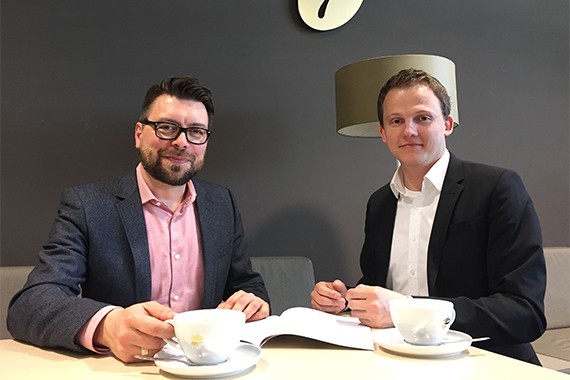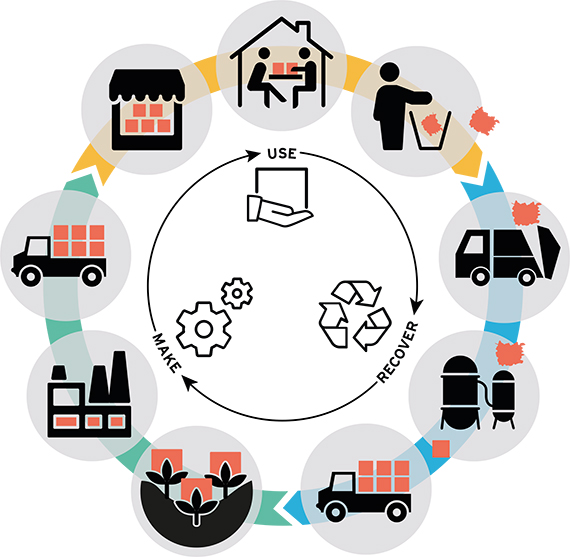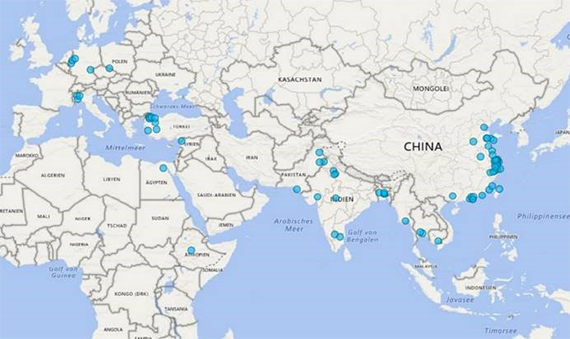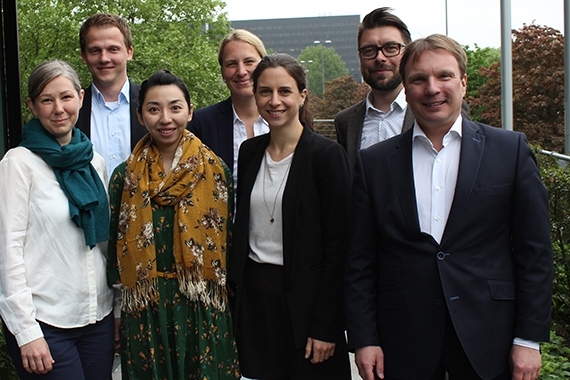
Detoxing the textile industry
In November 2014, Tchibo signed the Greenpeace Detox Commitment. In other words, we have pledged to ban hazardous chemicals from the production of textiles by 2020. What does that mean? What is Detox about, specifically? What has been achieved so far? And what challenges still lie ahead? Project managers Daniel Koltermann and Friedemann Schreiter answer these and many other fascinating questions.
Project managers Daniel Koltermann (left) and Friedemann Schreiter (right).
What is the goal of the Detox project?
Daniel Koltermann: Most textile production today takes place in Asia (e.g. in. China and Bangladesh). The production of textiles often involves using large quantities of water and hazardous chemicals (in dyeing, printing, and finishing plants). Tchibo ensures that hazardous substances are eliminated from the product. Each product is tested for compliance with the specifications before going on sale. What Greenpeace is aiming at, however, is the local environment. Production often involves untreated wastewater being discharged into rivers or lakes. To raise awareness of this issue and to initiate systemic changes, Greenpeace launched the Detox project in 2011, which aims to eliminate all hazardous substances from the supply chains of all major textile brands and retail companies by 2020. The goal of the project is ambitious, but also absolutely the right way to go, in Tchibo’s view. We only have one natural environment and we must protect it.

That sounds like a big challenge…
Friedemann Schreiter: Yes, and it is. Tchibo's wide product range in particular is a huge challenge. In addition, the relevant wet processes are often handled not in our contractors’ factories, but further upstream in the supply chain. We have no direct business relationships with these companies, and are often only one of many customers, through our suppliers. Besides, there are no suitable alternatives yet for many chemicals that are critical (but important in the production process). For some hazardous substances, complete elimination is not possible because they are natural elements of our ecosystem, such as heavy metals. As you can see, to achieve real change, structural changes need to be triggered in the global textile industry. And that is what the Detox project aims at. All protagonists in the textile supply chain will have to do something.

What specifically has happened since the Detox Commitment was signed?
Daniel Koltermann: First, we set up our in-house project team. In addition to a six-strong core team, it includes other colleagues from specialist departments such as quality, Purchasing or Product Management. External experts are also involved in this ambitious project. In the second step, we have begun to create transparency concerning the relevant steps in our textile supply chains. We have significantly increased awareness of the problem through conversations with suppliers – increasingly, our discussions revolve not around ‘whether’ but around ‘how’ we are going to do this. We have tested and implemented possible solutions with a group of strategic suppliers that manufacture more than 47% of the textiles produced for Tchibo.
For example?
Daniel Koltermann: We created additional positions and responsibilities for chemicals management at suppliers. We have cases where investments were made in wastewater-treatment plants. Detox-relevant information is being added to the inventory lists of chemicals.
What proportion of water pollution is the global textile industry actually responsible for?
Friedemann Schreiter: It is estimated that the global textile industry causes about 20% of the industrial pollution of surface water, such as rivers and lakes. However, the indirect consequences of this pollution are much more far-reaching. The discharge of hazardous substances into the water and soil harms living beings and even enters the food chain. PFC substances are even detected in the Antarctic, so we are dealing with a truly global problem here, one that affects all of us.

Why don’t the governments of many production countries enact stricter laws to protect people and the environment?
Daniel Koltermann: A lot is already happening at a local level in many countries. There is a wide range of citizens’ movements against environmental pollution, as well as widespread awareness that industrial pollution of aquatic environments affects not only the environment but also the health of the entire population. Besides, in my experience the lack of laws is often not the problem. Mostly, they exist on paper, but are not enforced. And we mustn’t forget that the environmental movement in Germany and Europe took more than 100 years to reach mainstream society.
Friedemann Schreiter: I’d like to add that while binding standards for all companies would certainly be a welcome development, the sphere of governmental influence is still strongly confined to national borders – and today’s economic and trade relations take place on global markets. So government regulation of global markets still tends to be difficult to this day. This is also the reason that Greenpeace advocates political change at international level and we are proactively pushing forward the improvement of social and environmental standards in our supply chains.
Can Tchibo make any difference as a single company?
Friedemann Schreiter: In individual cases, a lot can be achieved. It’s much more difficult to make industry-wide changes, which is why we join forces with other organisations to achieve a greater impact, together. For example, we are currently working with the German Association for International Cooperation (GIZ) and the REWE Group to develop a detox qualification programme in Bangladesh and China. This gives us an opportunity to lastingly change the textile industry in these countries.

Do our producers understand why we are demanding that they give up hazardous chemicals in production?
Daniel Koltermann: Understanding and awareness of the problem are definitely a given with most of our producers. However, there is still a lot of uncertainty about how to go about eliminating hazardous chemicals in practice. Which chemicals are hazardous? Where can I get alternatives? What do they cost? Will my production costs rise? Will this lead to competitive disadvantages? Transparent, trusting and dialogue-oriented supplier relationships are essential for finding answers to questions like these.
Can’t you just attach a list to our purchasing contracts specifying which chemicals must not be used?
Daniel Koltermann: Such a list already exists – the Manufacturing Restricted Substances List (MRSL), but listing them alone doesn’t lead to the necessary changes at the suppliers. So the question is: what actually has to happen at a factory so that these chemicals are not used? Establishing an active chemicals management scheme that covers everything from procurement, storage and use to proper disposal is the basis for this. Then, based on this, a systematic substitution process in which the manufacturers of components and chemicals are involved as well. And as with all complex problems, here too, there is not just one correct solution.
So what do producers do if they find banned chemicals in the production process?
Friedemann Schreiter: First of all, it is important to find the cause. Is it due to contamination during the production process? Or was the chemical deliberately used as a component? If so, where exactly in the production process? In which formula was the chemical used? Which manufacturer supplied the chemical? Did the manufacturer provide the proper information about the chemical formulation? Is all the key information recorded in my (the producer’s) chemical inventory? Only when it has been clarified what substance it is exactly, and how it got into the production process can the producer try to replace it with a less hazardous chemical.
What are the next steps for the Detox project?
Daniel Koltermann: We will continue to systematically review the preliminary production stages. We will also help our suppliers and their wet plants improve their chemicals management. This includes developing the training programme I mentioned earlier, which we want to use to trigger changes across the industry. And as some monitoring will be necessary, we are currently developing an integrated monitoring programme to continuously check the quality of the wastewater in our factories. And, of course, we also plan to keep our customers informed about the Detox project in future blog posts.